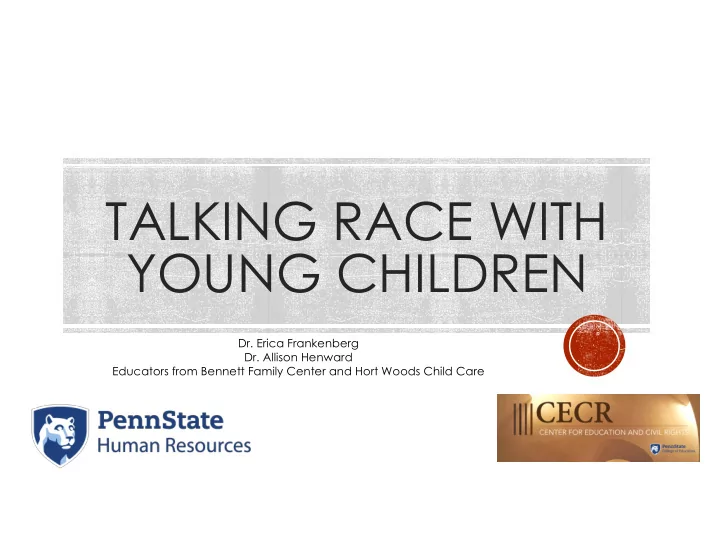

TALKING RACE WITH YOUNG CHILDREN Dr. Erica Frankenberg Dr. Allison Henward Educators from Bennett Family Center and Hort Woods Child Care
More than two-thirds of millenials agreed: § Society would be better if it were truly colorblind and never considered race § Focusing on race & ethnicity prevents our society from becoming truly colorblind And yet 80% admit that their friends have racial bias. Less than half report that race was a common topic in their household growing up, and only 20% feel comfortable having conversations about bias. 2014 MTV Strategic Insights - David Binder Research Survey on Millennials & Bias
Individual-level Systemic-level Internalized: lies within Institutional: occurs within institutions and individuals. Examples are systems of power. Examples are school private beliefs and biases districts that concentrate students of color about race and racism. in schools that have the fewest resources. Interpersonal: occurs between Structural: racial bias among institutions individuals. Example: how and across society, involving the individuals’ racial beliefs affect cumulative effect of many societal & their interactions with others historical factors that privilege white people and disadvantage students of color. Example: how people of color are treated while seeking employment.
Importance of daily inquiry as parents/educators: § Am I seeing, understanding, and addressing: § how society is treating me and my children as racial group members? § communities and individuals in their full complexity? § the ways opportunities to learn are unequally distributed to racial groups? § What actions offer opportunities to children in such a world? § Do my everyday acts promote a more equitable society? Adapted from Everyday Antiracism.
§ Based on NAEYC Code of Ethical Conduct § “Although there are rightfully many different perspectives and opinions on public policies, the early childhood profession has clear responsibilities and professional commitments to the wellbeing of every child.” - Derman-Sparks & Edwards
§ Perceived Innocence of children § History and current state of racism § Parents and teachers are concerned about “doing it wrong”
§ Children see exclusion and rejection based on race every day § Pretending it doesn ’ t exist won’t make it go away and makes it worse (Pollock, 2015) § Families of color often have to have conversations to prepare children for race and racism (Hill-Collins, 2000; Ladson-Billings, 2009) § White families don’t have to and often times don’t (Adair & Doucet, 2013; Vittrup, 2015)
COLORBLINDNESS AND HAIRCUTS
§ Many of us are taught from an early age that talking about race – even just acknowledging race – is a no-no. § Colorblindness “I don’t see color. I just see people.” or “We are all just people.” § Colormuteness: not talking about racialized names.
§ “Does it come off?” she asked. § “Does what come off?” I asked back. § “The black.” She was rubbing her arm on mine as if to get some of my skin color on her. § Her mother, who had been sitting near us, gasped. She turned to me, pale and embarrassed. “I don’t know where she’d come up with such a thing,” she said. “We never talk about … things like that.” She pulled her daughter out of the water and ended the lesson, shushing the girl as they left.
§ Bennett Family Center § Hort Woods
§ Every book needs to be accurate, caring, and respectful. § Check the Illustrations - Look for Stereotypes § Look for Tokenism: Is there one person of color? § Look for Invisibility: Who is missing? § Many children’s books use animal characters instead of people: such books are not a substitute for exploring issues of diversity and anti-bias fairness with people as the main characters. § Avoid overuse of folk tales to "teach" about a specific ethnic/cultural group leads to misinformation and confusion.
◦ Can be uneasy and can produce anxiety ◦ Takes place in a community of trust (Ladson-Billings,2009) ◦ Require Listening and Questioning ◦ Go deep ◦ Are honest ◦ Show how this happens in life ◦ Involve families and communities
First ten minutes: How has what’s been shared resonate with you and your prior experiences? Second ten minutes: Name a wondering or core tensions you are feeling.
Recommend
More recommend